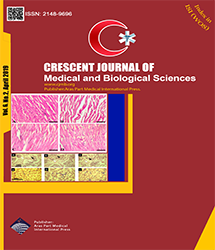
| Original Article | |
| Genotyping, Pandrug Resistance, Extensively Drug-Resistant, and Multi Drug-Resistance Detection of Pseudomonas aeruginosa Isolated From Patients in the West of Iran | |
| Samaneh Rouhi1,2, Rashid Ramazanzadeh2,3, Bijan Nouri4 | |
| 1Student Research Committee, Kurdistan University of Medical Sciences, Sanandaj, Iran 2Cellular and Molecular Research Center, Research Institute for Health Development, Kurdistan University of Medical Sciences, Sanandaj, Iran 3Microbiology Department, Kurdistan University of Medical Sciences, Sanandaj, Iran 4Social Determinants of Health Research Center, Research Institute for Health Development, Kurdistan University of Medical Sciences, Sanandaj, Iran |
|
|
CJMB 2019; 6: 170-177 Viewed : 5547 times Downloaded : 2856 times. Keywords : Genotyping, Pandrug Resistance, Extensively Drug resistance, Multidrug resistance, Pseudomonas aeruginosa |
|
| Full Text(PDF) | Related Articles | |
| Abstract | |
Objectives: Resistance to multiple antibiotic classes is called multidrug resistance (MDR), extremely drug resistance (XDR), and pandrug resistance (PDR). In addition, the genotyping survey of resistant bacteria is a prominent factor in epidemiological surveying. Therefore, the present study aimed to conduct an epidemiological survey in order to detect XDR, MDR, and PDR of Pseudomonas aeruginosa isolated from clinical specimens in Kurdistan province, Iran. Materials and Methods: During (December) 2015-(August) 2017, a total of 134 strains of P. aeruginosa were detected by the polymerase chain reaction and were tested for antibiotic resistance, MDR, XDR, and PDR. The related specimens of the patients with nosocomial infections were subjected to BOX-PCR analysis. Finally, the data were analyzed using Stata software with frequency determination, Fisher exact test, and Logistic regression (P ≤ 0.05). BOX-PCR analysis was performed by GelJ version 1.13 software. Results: Based on the results, the lowest and highest resistance and susceptibility rates in 134 isolates of P. aeruginosa were related to cefpodoxime (93.28%), imipenem (27.61%), colistin (69.40%), and cefpodoxime (6.71%), respectively. In addition, MDR and XDR isolates were observed in 97.76% and 15.67% of P. aeruginosa isolates, respectively. However, PDR was detected in none of the isolates while BOX-PCR demonstrated four main clusters with 56 unique patterns in nosocomial infection isolates. Further, a significant relationship was observed between MDR and XDR isolates and nosocomial infection (P ≤ 0.05). Eventually, there was a significant association between ward, the type of specimens, and hospitals with nosocomial infection (P ≤ 0.05). Conclusions: In general, a high frequency of antibiotic resistance was observed in this study whereas no genetic correlation was observed between P. aeruginosa strains. In sum, selecting the most effective antibiotics and devising an efficient way for controlling the antibiotic resistance should be taken into consideration. Supplementary Files |
Cite By, Google Scholar
Online Submission System
 CJMB ENDNOTE ® Style
CJMB ENDNOTE ® Style
 Tutorials
Tutorials
 Publication Charge
Medical and Biological Research Center
About Journal
Publication Charge
Medical and Biological Research Center
About Journal
Aras Part Medical International Press Editor-in-Chief
Arash Khaki
Deputy Editor
Zafer Akan


















